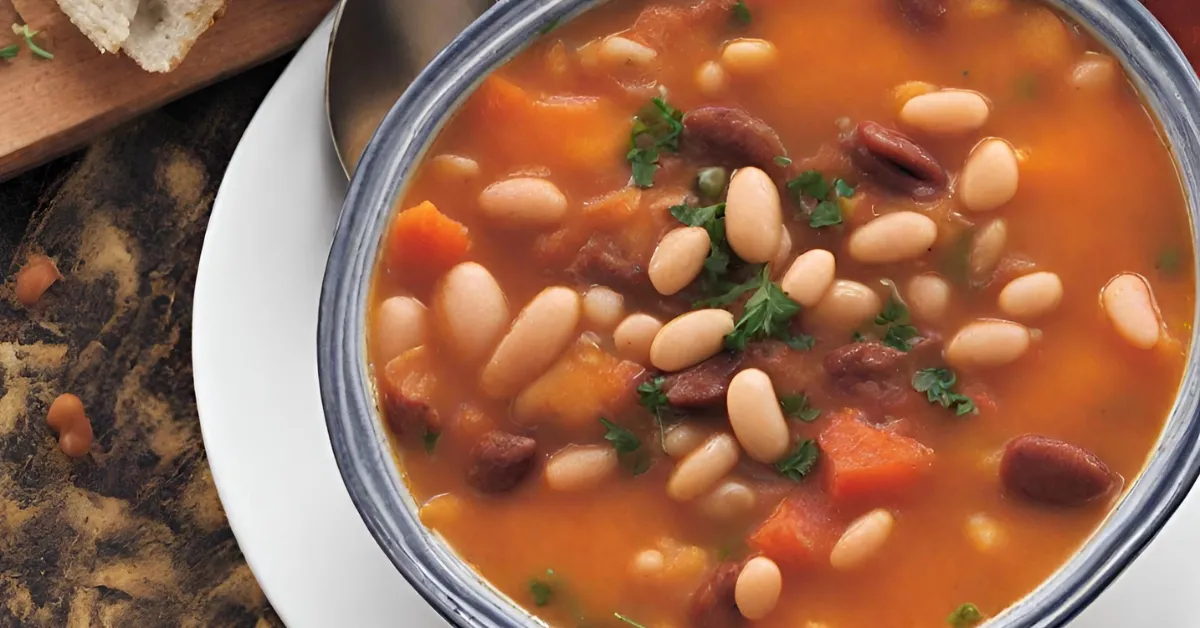Portuguese cuisine is a treasure trove of rich flavors, traditional recipes, and hearty dishes. One such beloved recipe is the Portuguese bean soup, a flavorful and satisfying dish that has been passed down through generations. In this guide, we will delve into the world of Portuguese bean soup, exploring its ingredients, preparation, and the cultural significance it holds.
Discover the Richness of Portuguese Cuisine
Portuguese cuisine is a fascinating blend of flavors, ingredients, and culinary traditions that have been shaped by centuries of history, geographical diversity, and cultural influences. The food in Portugal is hearty, flavorful, and deeply rooted in the local produce, seafood, and meats available in the region.
The Essence of Portuguese Cooking
At the heart of Portuguese cooking is a love for fresh ingredients, bold flavors, and simple preparation methods that let the natural taste of the food shine through. Olive oil, garlic, onions, and a variety of herbs and spices are staple components in many Portuguese dishes, creating a foundation of flavors that is both comforting and invigorating.
Portuguese cuisine also makes extensive use of seafood, owing to the country’s long coastline. Fresh fish and shellfish are a staple in the Portuguese diet, often grilled or served in stews and soups. Bacalhau, or salted codfish, is a national dish and is said to be prepared in over a thousand different ways.
Regional Varieties
The food in Portugal varies significantly from region to region, with each area offering its own unique dishes and specialties. In the north of Portugal, the cuisine is heartier and more robust, with a focus on meat, sausages, and hearty stews. The central region of the country features more seafood and vegetable-based dishes, while the south, particularly the Algarve, is known for its spicy, Moorish-influenced cuisine.
Portuguese desserts are also a highlight of the cuisine, with many recipes featuring eggs, almonds, and sugar in various forms. Pastéis de Nata, or custard tarts, are perhaps the most famous Portuguese dessert and are enjoyed by locals and visitors alike.
The Unique Ingredients of Portuguese Bean Soup
Portuguese Bean Soup, also known as “Sopa de Feijão”, is a hearty and flavorful dish that is deeply rooted in Portuguese culinary traditions. The unique blend of ingredients used in this soup is what sets it apart from other bean soups and stews. Below, we delve into the key components that make this dish so special.
Beans: The Heart of the Soup
- Feijão: This is the Portuguese word for beans. The most commonly used beans in this soup are kidney beans, but you can also find variations using white beans or pinto beans. The beans are soaked overnight and then simmered until tender, providing a creamy texture and rich flavor to the soup.
The Meat: A Flavorful Addition
- Chouriço or Linguiça: These are traditional Portuguese sausages, made from pork and seasoned with garlic, paprika, and other spices. The sausages are sliced and added to the soup, infusing it with a smoky, spicy flavor.
- Ham Hock or Pork Belly: Some recipes also include a piece of ham hock or pork belly, which adds a rich, savory depth to the soup.
Vegetables: A Nutritious Touch
- Kale or Collard Greens: These leafy greens are a common addition to Portuguese Bean Soup, adding color, texture, and a host of vitamins and minerals.
- Potatoes: Cubed potatoes are added to the soup, providing a hearty, comforting element.
- Carrots and Onions: These aromatic vegetables are sautéed to create the flavor base for the soup, contributing sweetness and depth.
The Broth: A Flavorful Foundation
- Chicken or Beef Stock: The stock serves as the base for the soup, and using a high-quality stock is key to achieving the best flavor.
- Tomato Paste: A small amount of tomato paste is added to the broth, giving the soup a slight tanginess and rich color.
Spices and Herbs: The Final Flourish
- Bay Leaves, Garlic, and Paprika: These spices and herbs are essential to creating the authentic flavor of Portuguese Bean Soup. Bay leaves add a subtle herbal note, garlic contributes a pungent kick, and paprika provides warmth and smokiness.
- Coriander or Cilantro: Some recipes also include fresh coriander or cilantro, which is stirred in at the end for a burst of freshness.
Read:
- Grandma Browns Baked Beans Recipe: A Timeless Family Favorite
- Crock Pot Wonton Soup
- Fridheimar Tomato Soup Recipe
The Journey of Crafting the Perfect Portuguese Bean Soup
The creation of a perfect bowl of Portuguese Bean Soup is akin to a delightful culinary adventure, blending tradition, patience, and a splash of creativity. Let’s embark on this journey together, exploring each step that contributes to the rich flavors and heartwarming qualities of this iconic dish.
Selecting the Right Ingredients
The first step on our path is the careful selection of ingredients. Opt for fresh vegetables, high-quality sausages like Chouriço or Linguiça, and choose your beans wisely—kidney, pinto, or white beans are all excellent choices. Don’t forget the crucial herbs and spices like garlic, paprika, and bay leaves, which are the soul of this soup.
Preparing the Beans
Once you have your ingredients, the journey continues with the preparation of the beans. Soak them overnight to ensure they cook evenly and provide the perfect creamy texture. This step requires patience, as the beans need time to absorb water and soften up for the cooking process.
Building the Flavor Base
With your beans ready, turn your attention to building a robust flavor base. Begin by sautéing onions and garlic, creating a fragrant foundation. As these aromatic ingredients sweat and soften, they release their essential oils, enveloping your kitchen in an enticing aroma.
Incorporating the Meats
Next, introduce the sliced Chouriço or Linguiça and any other meat of your choice, like ham hock or pork belly. Allow them to brown slightly, as this browning process contributes a deep, savory dimension to the soup.
Adding Vegetables and Broth
Once your meats are well-integrated, add the diced potatoes, carrots, and your leafy greens of choice. Stir in the tomato paste and pour in a generous amount of chicken or beef stock. These components come together to create a harmonious blend of flavors, with each ingredient playing its vital role.
Simmering to Perfection
Now, it’s time for the magic to happen. Let the soup simmer, allowing all the ingredients to meld together, transforming into a sumptuous concoction. The low and slow cooking process is crucial, as it gives time for the beans to become tender and the flavors to mature.
Finishing Touches
As your soup nears completion, add your final seasonings—salt, pepper, and any additional herbs like coriander or cilantro. These finishing touches are the final strokes in our culinary painting, elevating the soup to its pinnacle of flavor.
Savoring Your Creation
Finally, the moment you’ve been waiting for—the tasting. Ladle a generous portion into your bowl, inhale the aromatic steam, and take your first bite. The rich broth, hearty beans, and savory meats should come together in a symphony of flavors, each spoonful a testament to the journey you’ve embarked upon.
Serving Suggestions for Portuguese Bean Soup
Portuguese Bean Soup is a hearty and delicious dish that’s full of flavor and warmth, making it a perfect choice for any meal. When it comes to serving this delightful soup, there are numerous ways you can enhance the experience and make it even more enjoyable for your guests or family. Below are some top-notch serving suggestions that can elevate your Portuguese Bean Soup to the next level.
Choose the Right Bowl and Garnish
Presentation is key when serving any dish, and Portuguese Bean Soup is no exception. Opt for a rustic bowl to add to the charm of this traditional dish. Garnish with a sprinkle of fresh chopped parsley or cilantro, and a slice of lemon on the side for a burst of freshness.
Accompany with Crusty Bread
A slice of warm, crusty bread is the perfect accompaniment to Portuguese Bean Soup. The bread soaks up the delicious broth, while providing a satisfying crunch. Consider serving a traditional Portuguese cornbread (Broa) or a sourdough bread for an authentic experience.
Offer a Variety of Toppings
Provide a small platter of various toppings for your guests to choose from. This could include chopped onions, shredded cheese, sliced chorizo, or a drizzle of olive oil. These toppings allow each person to customize their bowl of soup to their liking.
Pair with a Light Salad
A light salad on the side can balance out the richness of the soup. Opt for a simple green salad with a lemon vinaigrette or a tomato and cucumber salad with fresh herbs. The acidity and freshness of the salad will complement the hearty flavors of the soup.
Finish with a Traditional Portuguese Dessert
Round off your meal with a traditional Portuguese dessert. Pastéis de Nata (custard tarts) or Arroz Doce (rice pudding) are both excellent choices that will leave your guests satisfied and impressed.
Provide a Side of Olives or Pickles
A small bowl of Portuguese olives or pickles can add an extra layer of flavor to your meal. The brininess of the olives or pickles will complement the savory flavors of the soup.
Consider a Vegetarian Option
If you have vegetarian guests, consider providing a vegetarian version of the Portuguese Bean Soup. Use vegetable broth instead of meat broth and add a variety of vegetables to ensure the soup is hearty and flavorful.
Utilize Fresh Herbs
Fresh herbs can add a burst of flavor and color to your Portuguese Bean Soup. Consider using herbs such as thyme, bay leaves, or rosemary for a fragrant and flavorful addition.
Experiment with Spices
Don’t be afraid to experiment with different spices to add depth and warmth to your soup. A pinch of paprika, cumin, or coriander can enhance the flavors and make the soup even more delicious.
Elevating Your Soup: Garnishes and Add-ons
Taking your soup from good to great is all about the details. Just like a well-chosen accessory can complete an outfit, the right garnishes and add-ons can elevate your soup to a whole new level of deliciousness. Whether you’re serving a classic Portuguese bean soup or experimenting with other flavors, here’s how you can enhance your soup experience.
Fresh Herbs: A Sprinkle of Flavor
A sprinkle of fresh herbs can add a burst of color and flavor to your soup. Consider basil, cilantro, or parsley for a fresh and vibrant addition. Not only do they add a layer of flavor, but they also provide a pop of color that makes your dish visually appealing.
Crunchy Croutons: A Textural Delight
Croutons provide a delightful crunch that contrasts beautifully with the smoothness of the soup. You can make your own croutons by cubing bread, tossing it with olive oil, and baking it until crisp. For an extra flavor kick, add garlic, herbs, or parmesan cheese to the mix.
Cheese: A Creamy Indulgence
A sprinkle of grated cheese can add a creamy, indulgent touch to your soup. Parmesan, cheddar, or feta all work well, melting into the soup to create a rich and delicious experience.
Zesty Citrus: A Bright Touch
A squeeze of fresh lemon or lime juice can brighten up your soup, adding a zesty and refreshing flavor. Alternatively, you can serve a wedge of citrus on the side for diners to add as they please.
Spicy Heat: A Fiery Addition
For those who enjoy a bit of heat, consider adding a sprinkle of red pepper flakes, a dash of hot sauce, or some sliced fresh chili. This will add a fiery kick to your soup, awakening the taste buds and adding an exciting dimension to the dish.
Creamy Dollop: A Luxurious Finish
A dollop of cream, sour cream, or Greek yogurt can add a luxurious, creamy finish to your soup. The coolness of the dairy contrasts beautifully with the warmth of the soup, creating a balanced and indulgent experience.
Toasted Nuts: A Nutty Nuance
Toasted nuts such as pine nuts, almonds, or walnuts add a delightful nutty flavor and crunchy texture to your soup. They provide a contrast in texture and a boost of flavor that is sure to impress.
Sliced Avocado: A Buttery Accent
Slices of ripe avocado add a buttery, creamy element to your soup. They bring a richness and depth of flavor that is both unexpected and delicious.
Olive Oil: A Drizzle of Luxury
A drizzle of good-quality olive oil can add a luxurious finish to your soup. It adds a richness and depth of flavor, enhancing the overall experience of the dish.
Fresh Vegetables: A Crunchy Contrast
Adding fresh, crunchy vegetables such as diced bell peppers, cucumbers, or radishes can provide a refreshing contrast to the warmth of the soup. They add a burst of freshness and a crunch that is both delightful and unexpected.
Storing and Reheating Your Portuguese Bean Soup
After indulging in the rich and hearty flavors of your homemade Portuguese Bean Soup, you might find yourself with leftovers. Fear not, for this soup is just as delightful the next day, if not more so, as the flavors continue to meld together. Here’s your guide to properly storing and reheating your soup to enjoy it to its fullest.
Proper Storage Techniques
The key to preserving the freshness and flavor of your Portuguese Bean Soup is proper storage. Allow the soup to cool to room temperature before transferring it to an airtight container. Be sure to do this within two hours of cooking to prevent any bacterial growth. Store it in the refrigerator if you plan to consume it within the next 3-4 days. For longer storage, the freezer is your best friend.
Freezing for Future Feasts
Portuguese Bean Soup freezes exceptionally well. Pour the cooled soup into freezer-safe bags or containers, leaving some space at the top as the soup will expand as it freezes. Label the containers with the date, so you can keep track of how long they’ve been stored. Properly stored, your soup can last in the freezer for up to 2-3 months.
Reheating on the Stovetop
When you’re ready to revisit the comforting flavors of your soup, thaw it in the refrigerator overnight if it’s been frozen. To reheat, pour the soup into a pot and warm it over medium heat. Stir occasionally to ensure even heating and prevent any sticking at the bottom. If the soup appears too thick, you can add a bit of water or broth to reach your desired consistency.
Microwaving for Convenience
If you’re in a hurry, the microwave is a convenient option. Place a serving of the soup in a microwave-safe bowl, cover it with a microwave-safe lid or plastic wrap, and heat on high for 2-3 minutes. Stir the soup halfway through to ensure even reheating. Be cautious when removing the cover, as steam will escape, and it can be quite hot.
Restoring the Freshness
Upon reheating, you might find that the flavors have intensified, which is one of the magical qualities of soups and stews. However, if you feel the need to refresh the taste, consider adding a sprinkle of fresh herbs such as coriander or parsley. A squeeze of lemon juice can also brighten up the flavors.
Safety Considerations
Always check the temperature of your reheated soup to ensure it has reached 165°F (74°C), making it safe to eat. Avoid reheating the soup multiple times, as this can compromise both its taste and safety.
Portuguese Bean Soup Recipe Variations
Portuguese Bean Soup, with its rich and hearty flavors, is a classic dish beloved by many. However, like any good recipe, it can be adapted and tweaked to suit different tastes, dietary needs, or to just add a bit of variety to your cooking repertoire. Below, we explore some delicious variations of the traditional Portuguese Bean Soup recipe.
Vegetarian Portuguese Bean Soup
For those who follow a vegetarian diet, this variation is a must-try. Swap out the traditional meat components with plant-based alternatives like veggie sausages or tempeh. Use a rich vegetable broth instead of the usual chicken or beef stock. Load up on a variety of beans and vegetables to ensure the soup remains hearty and satisfying.
Spicy Portuguese Bean Soup
If you’re a fan of spice, this variation will be right up your alley. Add in some extra heat with a generous helping of red pepper flakes, diced jalapeños, or a splash of hot sauce. The added spice will give the soup an exciting kick and add a new dimension to the flavor profile.
Seafood-Inspired Portuguese Bean Soup
Take a coastal twist on the traditional recipe by incorporating seafood elements. Try adding in chunks of firm white fish, shrimp, or even mussels. The seafood will infuse the broth with a deliciously rich flavor, reminiscent of the coastal regions of Portugal.
Low-Fat Portuguese Bean Soup
For a lighter version of the classic dish, consider making a few substitutions to reduce the fat content. Use turkey sausage instead of the traditional linguiça or chorizo, and opt for a lean cut of ham. Additionally, you can reduce the amount of oil used to sauté the vegetables.
Creamy Portuguese Bean Soup
If you prefer your soups on the creamier side, this variation is worth trying. After the soup has finished cooking, take an immersion blender and carefully blend part of the soup to create a creamy texture. Alternatively, you could add a splash of cream or coconut milk for an extra luxurious touch.
Herb-Infused Portuguese Bean Soup
Herbs are a wonderful way to add depth of flavor to your soup. This variation incorporates a variety of fresh or dried herbs such as thyme, rosemary, or bay leaves. Add them in while the soup is simmering to allow their flavors to fully infuse the broth.
Tropical Portuguese Bean Soup
Add a tropical twist to your soup by incorporating ingredients commonly found in Portuguese colonies like Brazil or Mozambique. Try adding in chunks of sweet potato, slices of plantain, or even a splash of coconut milk. These ingredients will add a unique sweetness and richness to the soup.
Hearty Meat Lovers’ Portuguese Bean Soup
For those who love a meaty soup, this variation is packed with additional proteins. Include extra cuts of pork, beef, or even chicken. You could also add in some bacon or chorizo for an extra smoky flavor.
Portuguese Bean Soup with a Twist of Lime
Adding a splash of lime juice just before serving gives this soup a bright and zesty flavor. The acidity of the lime helps to balance out the richness of the broth, providing a refreshing twist to the traditional recipe.
Gluten-Free Portuguese Bean Soup
To make this recipe gluten-free, ensure that all processed ingredients like sausages and broth are labeled as gluten-free. You could also make your own broth and sausages from scratch to ensure they meet gluten-free standards.
FAQs
Can I eat beans everyday?
Yes, you can incorporate beans into your daily diet as they are an excellent source of protein, fiber, and essential nutrients. However, it’s crucial to maintain a balanced diet with a variety of foods to ensure you receive all necessary nutrients. If you are not accustomed to a high-fiber diet, start slowly to allow your digestive system to adjust and drink plenty of water to aid in digestion.
Is it good to eat beans at night?
Beans are rich in protein and fiber, which can keep you feeling full and satisfied. However, for some people, eating beans at night might cause discomfort or bloating due to their high fiber content. If you choose to eat beans in the evening, pay attention to portion sizes and consider how your body reacts.
Can I eat bean soup on a diet?
Absolutely! Bean soup can be a healthy addition to your diet, especially if it’s loaded with vegetables and lean proteins. The fiber in beans helps to keep you full, making it easier to stick to your diet. However, be mindful of the portion size and the added ingredients to keep the calorie count in check.
How many calories are in Portuguese bean soup?
The calorie content in Portuguese bean soup can vary based on the recipe and portion size. On average, a one-cup serving might contain anywhere from 200-300 calories. To get an accurate count, consider the ingredients used and use a nutritional calculator, especially if you are monitoring your caloric intake.
Conclusion
Portuguese Bean Soup stands as a testament to the rich culinary heritage of Portugal, embodying the warmth, flavors, and communal spirit of its people. This hearty and flavorful dish is more than just a soup; it’s a journey through culture, tradition, and the joy of cooking with love.
From selecting the freshest ingredients and layering flavors to create a harmonious balance, to the patience required in simmering and the joy of sharing it with others, Portuguese Bean Soup is a culinary adventure worth embarking upon. Whether you are enjoying a bowl on a chilly evening, sharing it with family and friends, or savoring leftovers the next day, this soup is sure to leave a lasting impression on your palate and your heart.
Furthermore, the versatility of this dish allows it to fit into various dietary preferences and lifestyles, making it a timeless classic that can be enjoyed by many. The journey of crafting, storing, and reheating this soup also speaks to its resilience and the enduring nature of Portuguese cuisine.
As we conclude this culinary exploration, let’s celebrate the Portuguese Bean Soup for its rich flavors, comforting qualities, and the way it brings people together. Here’s to many more bowls of this delightful soup and the continued appreciation of Portugal’s gastronomic legacy. Bom apetite!
📖 Portuguese Bean Soup Recipe
Print
Portuguese Bean Soup Recipe
- Total Time: 2 hours 20 minutes
- Yield: 8 servings
- Diet: Gluten Free
Description
Savor the rich and hearty flavors of this traditional Hawaiian-Portuguese Bean Soup. Packed with savory sausage, tender beans, and fresh vegetables, it’s the perfect comfort food for any occasion.
Ingredients
1 lb Portuguese sausage, sliced
1 lb ham hock
One onion, chopped
3 cloves garlic, minced
2 carrots, peeled and sliced
2 potatoes, peeled and diced
A single can (15 oz) kidney beans, drained and rinsed
One can (15 oz) tomato sauce
1 cabbage, chopped
10 cups water
Salt and pepper to taste
Optional: macaroni pasta, as desired
Instructions
- In a large pot, brown the Portuguese sausage over medium heat. Remove and set aside.
- In the same pot, add the ham hock, onion, and garlic. Sauté until the onions are translucent.
- Add the carrots, potatoes, kidney beans, tomato sauce, and water. Bring to a boil.
- Reduce heat and simmer for 1-2 hours, or until the meat is tender and falls off the bone.
- Remove the ham hock, shred the meat, and return to the pot.
- Add the chopped cabbage and cooked Portuguese sausage. Simmer for an additional 15-20 minutes.
- Season with salt and pepper to taste. Add macaroni pasta if desired, and cook until tender.
- Serve hot and enjoy!
Notes
- The soup tastes even better the next day, as the flavors have time to meld together.
- You can substitute the Portuguese sausage with any other smoked sausage if it’s not available.
- Prep Time: 20 minutes
- Cook Time: 2 hours
- Category: Dinner
- Method: Stovetop
- Cuisine: Hawaiian-Portuguese
Nutrition
- Serving Size: 1 bowl (1/8th of recipe)
- Calories: 300
- Sugar: 5g
- Sodium: 800mg
- Fat: 10g
- Saturated Fat: 3g
- Unsaturated Fat: 5g
- Trans Fat: 0g
- Carbohydrates: 35g
- Fiber: 7g
- Protein: 20g
- Cholesterol: 30mg









